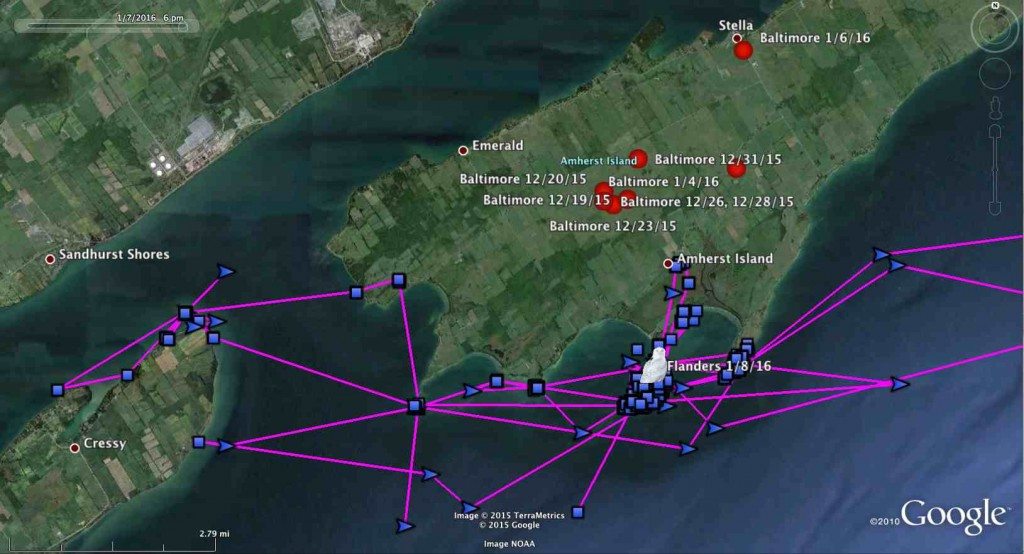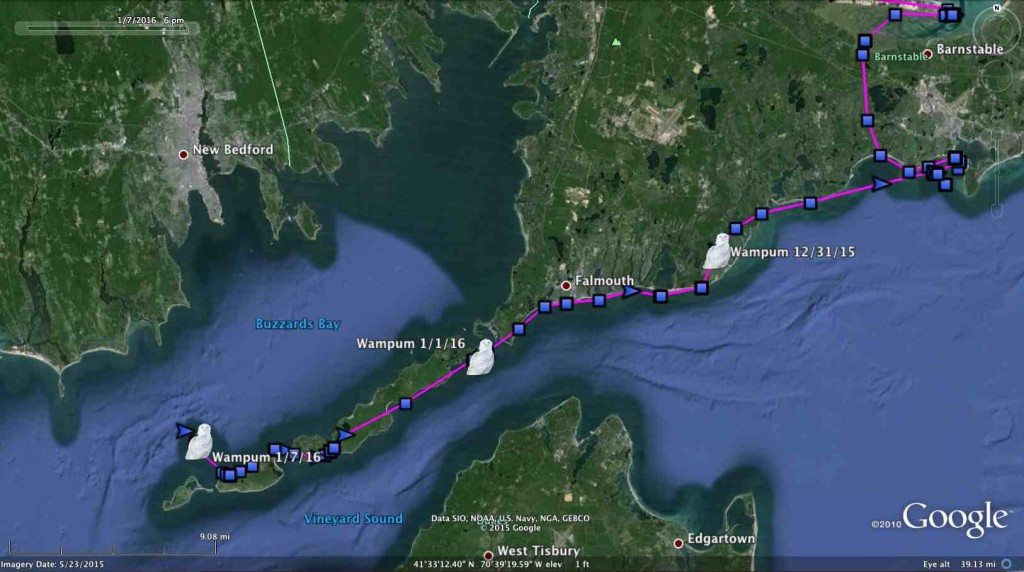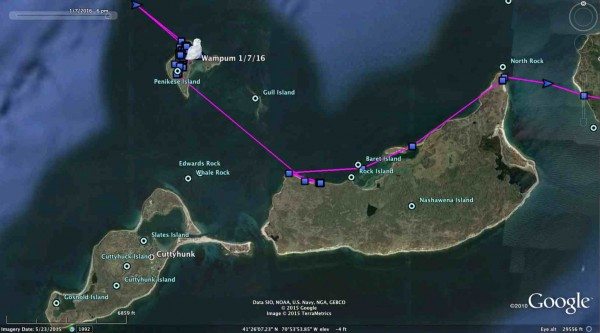
In the month since she was tagged, Flanders has moved back and forth across the northeastern margin of Lake Ontario. Baltimore’s evening locations, on the other hand, are largely confined to the interior of Amherst Island. (Project SNOWstorm and Google Earth)
All three of the snowies we’re actively tracking so far this winter are on islands — and one of them has gone about as far as she can in her particular archipelago.
Flanders and Baltimore remain, as they have been for several weeks, on Amherst Island in eastern Lake Ontario. Baltimore’s transmitter is still sending up backlogged data from his migration north, but we also get a current location for each transmission, usually just after dark, and he’s been holding tight in the immense, open fields at the center of the island, a mostly roadless area 2.5 km (1.5 miles) wide and 6.4 km (4 miles) long.
(More about Baltimore’s summer sojourn when we have a more complete picture of his movements then.)
Flanders remains on her island-next-to-an-island — Nut Island, just off the southern shore of Amherst. Except for a few excursions to the main island, she’s mostly staying on Nut, which is about a kilometer (.6 miles) long and largely treeless except around its perimeter.
But Wampum, who was moved from Boston’s Logan Airport to Cape Cod just before New Year’s, has really fetched up at the end of the line.

Wampum made a beeline down the length of the Elizabeth Islands in the days following her relocation from Logan Airport. (©Project SNOWstorm and Google Earth)
This adult female moved quickly after her release, flying 22 miles (36 km) southwest along the inner Elizabeth Islands to Nonamessett Island, spending the day there, then continuing another 13 miles (21 km) to the very end of the Elizabeth chain — Penikese Island, which sits in Buzzard’s Bay a mile north of Cuttyhunk.

Penikese Island — a former leper colony, and now home to a residential school for struggling teens — is where Wampum has been spending her time. (©Project SNOWstorm and Google Earth)
If she was looking for solitude, she found it. The 76-acre, state-owned island has a convoluted history; in 1905 Massachusetts established a leper colony there, and more recently, the island had a school for troubled boys for 38 years, until closing in 2011. (The school, now treating teens struggling with substance abuse and mental health disorders, reopened in 2013.) Most of the island is maintained as a wildlife preserve, sheltering nesting Leach’s storm-petrels and federally endangered roseate terns, among other species.
Other than one or two flights out over the bay, Wampum has been doing her hunting on the island, which like many of the islands in this part of New England is treeless and grassy, prime habitat for rodents and rabbits. She’s generally staying on the northern half of the island, away from the school and in an area near a small pond.
One thing we’re watching closely is the weather. It’s been a cloudy winter, even by the usual standards of the Great Lakes ands the New England coast, and except for a peek of sun last week we’ve seen very little solar recharge on Flanders’ and Baltimore’s units the past few weeks. Amherst Island is a great place for snowy owls, but not so much for solar panels. Wampum’s unit has seen more sun, fortunately.
The low battery level has been holding back Baltimore’s unit from sending the biggest batches of old data that it could, but Andy McGann and Sheldon Blackshire from CTT pushed through a new duty cycle that should help minimize battery drain and maximize what we get each time his unit connects. Under ideal conditions, we could get the full backlog in four connections — but at least for now, conditions along Lake Ontario’s north shore are going to remain cloudy and challenging.
The good news? His unit is still recording new data as well as pushing out the old stuff, and every day the sun gets higher and the days longer — so even with the stubborn cloud cover, we’re making progress.


8 Comments on “Island Owls”
The universal appeal of islands.
We’re going out to search for Baltimore and Flanders on Amherst Island this morn. There are many Snowies on the Island so the richness of the choices may present a challenge but we will look for the transmitters. Members of the Kingston Field Naturalists have also been alerted.
I’ve been watching the eBird reports with photos from Amherst, and have been surprised that no one’s posted a photo of either one yet — but of course, Flanders has been hanging out over on Nut Island most of the time, and Baltimore was away from roads. Both have moved closer to Stella, though, so you might get lucky — keep us posted! Baltimore’s summer data continues to come in, and is really exciting — can’t wait to have all of it so we can update everyone.
Lots of Snowies, 3 immature Bald Eagles, 20 Rough Legged Hawks, 2 Red Tail Hawks, 3 Harriers but NO TRANSMITTERS! Islanders are excited about Project Snowstorm and we will keep looking. Melissa arrives with her exceptional talent and equipment later this month.
Thanks for letting us know!
Somebody posted pics of one of the owls on the Ontario Birds FB group yesterday. The shots showed the solar panel on the backpack quite clearly.
Strange movement happening. Saturday, January 23 could not find a Snowy on Amherst Island during 4 hours of looking. Finally got one after dusk. We have had 20 counted here with at least 10 on regular posts. An unusual influx of Rough-legged hawks perhaps pushed north by U.S. storms. So many that we saw a Northern Harrier give up his prey to a Rough-legged advancing on him. may be too many hawks for owl comfort level. Will keep watching.
Janet Scott
janet scott As of last night, both Baltimore and Chaumont were still on Amherst, the former near Stella, the latter in the middle of the easternmost end of the island, pretty far from roads. Wish I was there to see the rough-leggeds…one of my favorite raptors. Great talking with you on CJAI FM this morning, Janet.